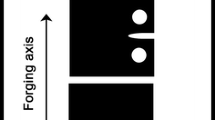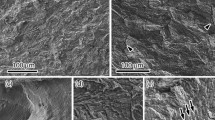Abstract
A study of the correlation between crack paths and crack growth response was undertaken to define better the elemental processes involved in gaseous hydrogen embrittlement. AISI 4340 steel fractured under sustained load in hydrogen and in hydrogen sulfide over a range of temperatures and pressures, whose crack growth kinetics have been well characterized previously, was chosen for study. Fractographic results showed that crack growth followed predominantly along prior-austenite grain boundaries, with a small amount of quasi-cleavage, at low temperatures. At high temperatures, crack growth occurred primarily by microvoid coalescence. The fracture surface morphology, which is indicative of the micromechanisms for crack growth, was essentially the same for hydrogen and hydrogen sulfide. Changes in fracture morphology,i.e., crack paths, corresponded to changes in crack growth kinetics, both of which depended on pressure and temperature. There was no evidence for crack nucleation in advance of the main crack, and this suggests that the fracture process zone is located within one prior-austenite grain diameter from the crack tip. The experimental results indicate that microstructure plays an important role in determining crack growth response. The prior-austenite grain boundaries are seen to be most susceptible to hydrogen embrittlement, followed by the (110)α’ and (112)α’ cleavage planes. The martensite matrix, on the other hand, is relatively immune. The observed changes in crack growth rate with temperature and pressure in the higher temperature region are explained in terms of the partitioning of hydrogen into the different microstructural elements and the consequent changes in the micromechanisms for fracture.
Similar content being viewed by others
References
D. P. Williams and H. G. Nelson:Metall. Trans., 1970, vol. 1, p. 63.
H. G. Nelson, D.P. Williams, and A. S. Tetelman:Metall. Trans., 1971, vol. 2, p. 953.
G.W. Simmons, P.S. Pao, and R.P. Wei:Metall. Trans. A, 1978, vol. 9A, p. 1147.
M. Lu, P. S. Pao, N. H. Chan, K. Klier, and R. P. Wei: in Proceedings of Second Japan Institute of Metals International Symposium (JIMIS-2),Hydrogen in Metals, Suppl. to Trans. Japan Inst. Metals, 1980, vol. 21, p. 449.
M. Lu, P. S. Pao, T. W. Weir, G. W. Simmons, and R. P. Wei:Metall. Trans. A, 1981, vol. 12A, p. 805.
R.P. Wei: inHydrogen Effects of Metals, I. M. Bernstein and Anthony W. Thompson, eds., TMS-AIME, Warrendale, PA, 1981, p. 677.
R. P. Gangloff and R. P. Wei: inFractography in Failure Analysis, B. M. Strauss and W. H. Cullen, Jr., eds., ASTM STP 654, American Society for Testing and Materials, 1978, p. 87.
R.A. Oriani: inStress Corrosion Cracking and Hydrogen Embrittlement of Iron Base Alloys, J. Hochmann, J. Slater, and R.W. Staehle, eds., NACE-5, Houston, TX, 1978, p. 351.
R. A. Oriani:Berichte Bunsen-Gesellschaft für Physik Chemie, 1972, vol. 76, p. 848.
W. W. Gerberich, Y. T. Chan, and C. St. John:Metall. Trans. A, 1975, vol. 6A, p. 1485.
W. W. Gerberich: inHydrogen in Metals, I.M. Bernstein and A.W. Thompson, eds., ASM, Metals Park, OH, 1974, p. 115.
Shigehane Hinotani, Fukunaga Terasaki, and Fukukazu Natasato: in Proceedings of Second Japan Institute of Metals International Symposium (JIMIS-2),Hydrogen in Metals, Suppl. to Trans. Japan Inst. Metals, 1980, vol. 21, p. 421.
Yoneo Kikuta, Takao Araki, and Toshir Kutodo: inFractography in Failure Analysis, B. M. Strauss and W. H. Cullen, Jr., eds., ASTM STP 645, American Society for Testing and Materials, 1978, p. 107.
Takao Araki and Yoneo Kikuta: in Proceedings of Second Japan Institute of Metals International Symposium (JIMIS-2),Hydrogen in Metals, Suppl. to Trans. Japan Inst. Metals, 1980, vol. 21, p. 425.
J. P. Fidelle, J. Legrand, and C. Couderc: “A Fractographic Study of Hydrogen Gas Embrittlement in Steels,” TMS-AIME Paper No. F 71-81, 1971.
CD. Beachem:Metall. Trans., 1972, vol. 3, p. 437.
R. A. Oriani and P. H. Josephic:Acta Metall., 1974, vol. 22, p. 1065.
G.E. Kerns: Ph.D. Dissertation, The Ohio State University, Columbus, OH, 1973.
P. Mclntyre: inStress Corrosion Cracking and Hydrogen Embrittlement of Iron Base Alloys, J. Hochmann, J. Slater, and R.W. Staehle, eds., NACE-5, Houston, TX, 1978, p. 788.
H. G. Nelson and D. P. Williams: inStress Corrosion Cracking and Hydrogen Embrittlement of Iron Base Alloys, J. Hochmann, J. Slater, and R.W. Staehle, eds., NACE-5, Houston, TX, 1978, p. 390.
A.J. Stavros and H. W. Paxton:Metall. Trans., 1970, vol. 1, p. 3049.
S. K. Banerji, H. C. Feng, and C. J. McMahon, Jr.:Metall. Trans. A, 1978, vol. 9A, p. 237.
J.F. Lessar and W.W. Gerberich:Metall. Trans. A, 1976, vol. 7A, p. 953.
R. P. Gangloff: Ph.D. Dissertation, Lehigh University, Bethlehem, PA, 1974.
R.P. Gangloff and R.P. Wei:Metall. Trans. A, 1977, vol. 8A, p. 1043.
M.L. Wayman and G.C. Smith:Metall. Trans., 1970, vol. 1, p. 1189.
C. D. Beachem and R. M. N. Pelloux: in Fracture Toughness Testing and Its Application, ASTM STP 381, American Society for Testing and Materials, 1965, p. 210.
Ming Gao: M. S. Thesis in Metallurgy and Materials Engineering, Lehigh University, Bethlehem, PA, 1982.
R.P. Wei, S.R. Novak, and D.P. Williams:Mails. Res. & Stand., 1972, vol. 12, p. 75.
H. H. Johnson, J. G. Morlet, and A. R. Troiano:Trans. TMS-AIME, 1958, vol. 212, p. 528.
J. Kameda and C. J. McMahon, Jr.: inResearch in Progress, University of Pennsylvania, Philadelphia, PA, December 1979.
J.E. Costa and A.N. Thompson:Metall. Trans. A, 1981, vol. 12A, p. 761.
Ming Gao: Ph. D. Dissertation in Metallurgy and Materials Engineering, Lehigh University, Bethlehem, PA, 1982.
T. D. Lee, T. Goldenberg, and J. P. Hirth:Metall. Trans. A, 1979, vol. 1OA, p. 439.
R. A. Oriani and P. H. Josephic: inEnvironment Sensitive Fracture of Engineering Materials, Z. A. Foroulis, ed., TMS-AIME, Warrendale, PA, 1979, p. 232.
J. Crank:The Mathematics of Diffusion, Oxford University Press, 1976, p. 37.
A.A. Wells:Br. Weld. J., 1963, vol. 10, p. 563.
J. R. Rice and M. A. Johnson :Inelastic Behavior of Solid, McGraw-Hill, 1970, pp. 641–47.
H. H. Johnson: inHydrogen in Metals, I. M. Bernstein and A. W. Thompson, eds., ASM, Metals Park, OH, 1974, p. 35.
Author information
Authors and Affiliations
Additional information
Leave from the Department of Materials Science, Shanghai Jaio Tong University, Shanghai, People’s Republic of China.
Formerly Research Associate, Department of Mechanical Engineering and Mechanics.
Rights and permissions
About this article
Cite this article
Gao, M., Lu, M. & Wei, R.P. Crack paths and hydrogen-Afinssisted crack growth response in AlSi 4340 steel. Metall Trans A 15, 735–746 (1984). https://doi.org/10.1007/BF02644205
Received:
Issue Date:
DOI: https://doi.org/10.1007/BF02644205




